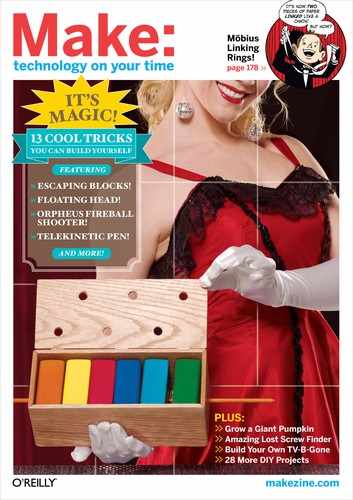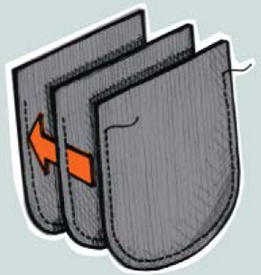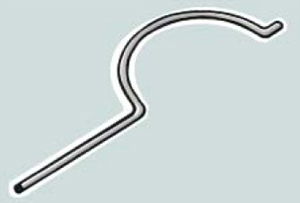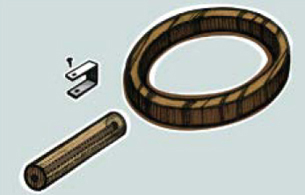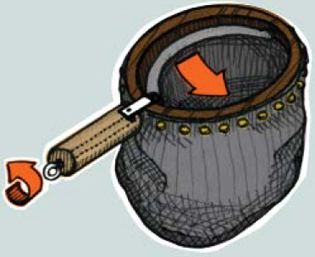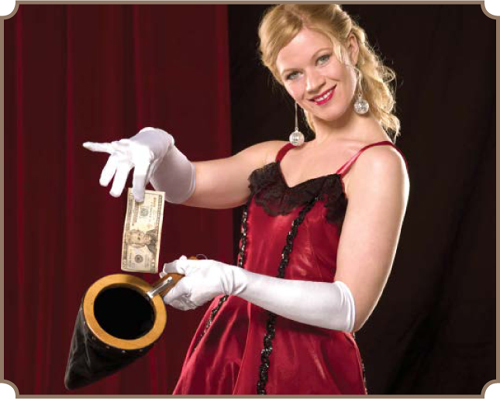
Photograph by Garry McLeod
Magic tricks with audience participation often entail borrowing something and then transforming it, or making it disappear and reappear. Any magician should have a variety of devices to assist in these basic operations. The double-compartment bag described here can serve that purpose, and although it’s based on a design that’s hundreds of years old, I haven’t seen it widely sold, probably because it wouldn’t be easy to mass-produce cheaply. Thus, modern audiences are unlikely to have seen it.
To give you an idea of how the bag can be used, here’s a routine centered around it that I call “The Power of Negative Thinking.”
How It Looks
The magician begins by mentioning the widespread belief that a positive mental attitude can lead to wealth and success. The magician himself doesn’t seem to be a stellar example, since he is still performing magic tricks and has not yet retired to the Bahamas as a billionaire, but maybe someone in the audience has a more impressive track record. If there is any such individual, would she or he be willing to step forward and contribute a 20-dollar bill for a quick field test of positive mental powers?
After a volunteer has been chosen, the magician shows him the bag and turns it inside out to emphasize that it’s empty. The magician then turns the bag right side out again and asks the volunteer to fold a 20-dollar bill in half before placing it in the bag. It’s important to emphasize that only the volunteer will touch the money.
The goal, now, is to transform the 20-dollar bill into a 50. The volunteer is asked to stare into the bag and think positively. “Did it work?” the magician asks after a short interval. He takes a peek himself. “Yes, I think it may have worked. Pull it out!”
The volunteer withdraws the bill, but instead of turning into a 50, it has turned into a 5. The magician becomes agitated. He accuses the volunteer of deliberately sabotaging the trick by applying negative energy. “You’d better give that to me,” says the magician. He takes the 5, puts it back into the bag, and this time, he applies his own powers of positivism, such as they are.
The situation now gets worse. The magician gropes inside the bag. He frowns. There’s nothing there! When he turns the bag inside out, he finds that the money has vanished completely.
What to do? Maybe a group effort will save this situation. The magician holds up the bag and asks the entire audience to exert positive energy, to save him from the humiliation of having to repay the volunteer with a check that is liable to be returned for insufficient funds. After another short wait, this time the magician claims to detect success. “Did you hear it?” he asks. “I distinctly heard the rustle of paper money.” Of course no one did hear it, but the magician is now confident. He asks the volunteer to put his hand in the bag, and sure enough, there’s some money in there. The volunteer pulls it out, and his original 20-dollar bill has been restored.
How It Works
The bag has 2 compartments, selected individually by shifting a divider that is attached to a semicircular loop of stiff wire concealed under the circular wooden frame that supports the mouth of the bag. The wire extends through a hole in the center of the handle and forms a loop at the end of the handle. The magician secretly turns the loop to rotate the semicircle of wire and expose one compartment or the other inside the bag. Since this procedure requires 2 hands, some misdirection is necessary while it’s taking place. The process of staring into the bag (supposedly to deliver positive vibrations) serves this purpose.
Initially, compartment A of the bag is secretly loaded with a 5-dollar bill, while compartment B is empty. This empty compartment is the one that’s exposed when the magician turns the bag inside out. The volunteer can then insert the 20-dollar bill into compartment B, provided the bag is not inspected too closely.
After allowing the volunteer to beam positive vibes into the mouth of the bag, the magician stares into it himself, simultaneously flipping the ring at the end of the handle to expose compartment A. The volunteer now removes the 5-dollar bill. The magician becomes concerned, repossesses the money, pushes it into the bag — but actually palms it and withdraws it. This is quite easy to do, since all attention is now on the bag, not on the magician.
The magician turns the bag inside out to show that the money has disappeared, then looks around as if hoping to see the money somewhere. This allows some misdirection during which the magician can slip the 5-dollar bill into his pocket, since it won’t be required again. He can also flip the bag back to compartment B. After the audience contributes positive vibes, the volunteer can get his money back. From this point onward, the bag is genuinely empty, allowing it to be turned inside out again for a quick inspection.
The bag must be made from thick fabric, so that when the volunteer places his money into it, he won’t feel the bill that’s hidden in the second compartment. At the same time the fabric must be sufficiently flexible so that it can be sewn around the semicircle of wire, allowing it to flip easily to and fro without making a sound. Felt is probably the best choice, and black the best color so that the mechanism inside the bag will be hidden in shadow.
NOTE: If you perform this trick, be careful that when you take the money out of the bag and palm it, you take your own, from compartment A, and not the volunteer’s money from compartment B. It would be a major embarrassment if you had to confess that you put his money in your pocket by mistake.
